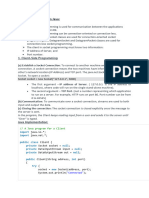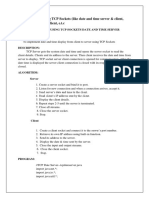Socket Programming in Java
Uploaded by
Kumar SaketSocket Programming in Java
Uploaded by
Kumar SaketSocket Programming in Java
This article describes a very basic one-way Client and Server setup where a Client connects, sends messages to server and the
server shows them using socket connection. There’s a lot of low-level stuff that needs to happen for these things to work but the
Java API networking package (java.net) takes care of all of that, making network programming very easy for programmers.
Client Side Programming
Establish a Socket Connection
To connect to other machine we need a socket connection. A socket connection means the two machines have information about
each other’s network location (IP Address) and TCP port.The java.net.Socket class represents a Socket. To open a socket:
Socket socket = new Socket(“127.0.0.1”, 5000)
First argument – IP address of Server. ( 127.0.0.1 is the IP address of localhost, where code will run on single stand-alone
machine).
Second argument – TCP Port. (Just a number representing which application to run on a server. For example, HTTP runs on
port 80. Port number can be from 0 to 65535)
Communication
To communicate over a socket connection, streams are used to both input and output the data.
Closing the connection
The socket connection is closed explicitly once the message to server is sent.
In the program, Client keeps reading input from user and sends to the server until “Over” is typed.
import java.net.*;
import java.io.*;
public class Client
{
// initialize socket and input output streams
private Socket socket = null;
private DataInputStream input = null;
private DataOutputStream out = null;
// constructor to put ip address and port
public Client(String address, int port)
{
// establish a connection
try
{
socket = new Socket(address, port);
System.out.println("Connected");
// takes input from terminal
input = new DataInputStream(System.in);
// sends output to the socket
out = new DataOutputStream(socket.getOutputStream());
}
catch(UnknownHostException u)
{
System.out.println(u);
}
catch(IOException i)
{
System.out.println(i);
}
// string to read message from input
String line = "";
// keep reading until "Over" is input
while (!line.equals("Over"))
{
try
{
line = input.readLine();
out.writeUTF(line);
}
catch(IOException i)
{
System.out.println(i);
}
}
// close the connection
try
{
input.close();
out.close();
socket.close();
}
catch(IOException i)
{
System.out.println(i);
}
}
public static void main(String args[])
{
Client client = new Client("127.0.0.1", 5000);
}
}
Server Programming
Establish a Socket Connection
To write a server application two sockets are needed.
A ServerSocket which waits for the client requests (when a client makes a new Socket())
A plain old Socket socket to use for communication with the client.
Communication
getOutputStream() method is used to send the output through the socket.
Close the Connection
After finishing, it is important to close the connection by closing the socket as well as input/output streams.
import java.net.*;
import java.io.*;
public class Server
{
//initialize socket and input stream
private Socket socket = null;
private ServerSocket server = null;
private DataInputStream in = null;
// constructor with port
public Server(int port)
{
// starts server and waits for a connection
try
{
server = new ServerSocket(port);
System.out.println("Server started");
System.out.println("Waiting for a client ...");
socket = server.accept();
System.out.println("Client accepted");
// takes input from the client socket
in = new DataInputStream(
new BufferedInputStream(socket.getInputStream()));
String line = "";
// reads message from client until "Over" is sent
while (!line.equals("Over"))
{
try
{
line = in.readUTF();
System.out.println(line);
}
catch(IOException i)
{
System.out.println(i);
}
}
System.out.println("Closing connection");
// close connection
socket.close();
in.close();
}
catch(IOException i)
{
System.out.println(i);
}
}
public static void main(String args[])
{
Server server = new Server(5000);
}
}
Important Points
Server application makes a ServerSocket on a specific port which is 5000. This starts our Server listening for client requests
coming in for port 5000.
Then Server makes a new Socket to communicate with the client.
socket = server.accept()
The accept() method blocks(just sits there) until a client connects to the server.
Then we take input from the socket using getInputStream() method. Our Server keeps receiving messages until the Client
sends “Over”.
After we’re done we close the connection by closing the socket and the input stream.
To run the Client and Server application on your machine, compile both of them. Then first run the server application and then
run the Client application.
You might also like
- LTSP Developing Information Technology INo ratings yetLTSP Developing Information Technology I76 pages
- Network Programming Assignment - 2021WA86148- CSIWZC462No ratings yetNetwork Programming Assignment - 2021WA86148- CSIWZC4628 pages
- Computer Network File Socket ProgrammingNo ratings yetComputer Network File Socket Programming26 pages
- AIM:-Create A Program That Will Communicate With The Server. (Echo Server/One Way Communication) TheoryNo ratings yetAIM:-Create A Program That Will Communicate With The Server. (Echo Server/One Way Communication) Theory9 pages
- EX - NO 3 (A) Applications Using TCP Sockets Like Echo Client and Echo Server AimNo ratings yetEX - NO 3 (A) Applications Using TCP Sockets Like Echo Client and Echo Server Aim4 pages
- 61FIT3NPR - W06 Tut TCP Socket and ThreadNo ratings yet61FIT3NPR - W06 Tut TCP Socket and Thread5 pages
- Network/Socket Programming in Java: Rajkumar BuyyaNo ratings yetNetwork/Socket Programming in Java: Rajkumar Buyya39 pages
- Krishna - Chavda - I077 - 60003220149 - CN - Experiment 5No ratings yetKrishna - Chavda - I077 - 60003220149 - CN - Experiment 52 pages
- Args Number Temp SC S sc1 S Number SC P S P Number Temp sc1 TempNo ratings yetArgs Number Temp SC S sc1 S Number SC P S P Number Temp sc1 Temp9 pages
- Practical Lab File Based ON Network Programming: Shiv Kumar Chaudhary Kurmi Mr. Vivek SoniNo ratings yetPractical Lab File Based ON Network Programming: Shiv Kumar Chaudhary Kurmi Mr. Vivek Soni40 pages
- Programs Using TCP Sockets (Like Date and Time Server & Client, Echo Server & Client, E.T.CNo ratings yetPrograms Using TCP Sockets (Like Date and Time Server & Client, Echo Server & Client, E.T.C20 pages
- Understanding Software Engineering Vol 3: Programming Basic Software Functionalities.From EverandUnderstanding Software Engineering Vol 3: Programming Basic Software Functionalities.No ratings yet
- Citrix Virtual Apps and Desktops: Installation Guide - Citrix Cloud General ConfigurationNo ratings yetCitrix Virtual Apps and Desktops: Installation Guide - Citrix Cloud General Configuration32 pages
- Website Development Services Agreement-1-2No ratings yetWebsite Development Services Agreement-1-22 pages
- FTL Interface On XMaster 4-1-98 en 01 2021No ratings yetFTL Interface On XMaster 4-1-98 en 01 202181 pages
- Safexpert Installation On Training ComputersNo ratings yetSafexpert Installation On Training Computers3 pages
- FINAL - MyCRM Quick Guide - Lending WayNo ratings yetFINAL - MyCRM Quick Guide - Lending Way12 pages
- Release-Notes vSpace-Client 1.8.0 (EN) 243769No ratings yetRelease-Notes vSpace-Client 1.8.0 (EN) 2437692 pages
- Handout 1 - Introduction To Computer NetworkingNo ratings yetHandout 1 - Introduction To Computer Networking17 pages
- Module Content Unit of Competency Module Title Module Descriptor100% (1)Module Content Unit of Competency Module Title Module Descriptor26 pages
- GstarCAD-2024-for-Linux-Activation-and-License-Return-GuideNo ratings yetGstarCAD-2024-for-Linux-Activation-and-License-Return-Guide25 pages

























































































